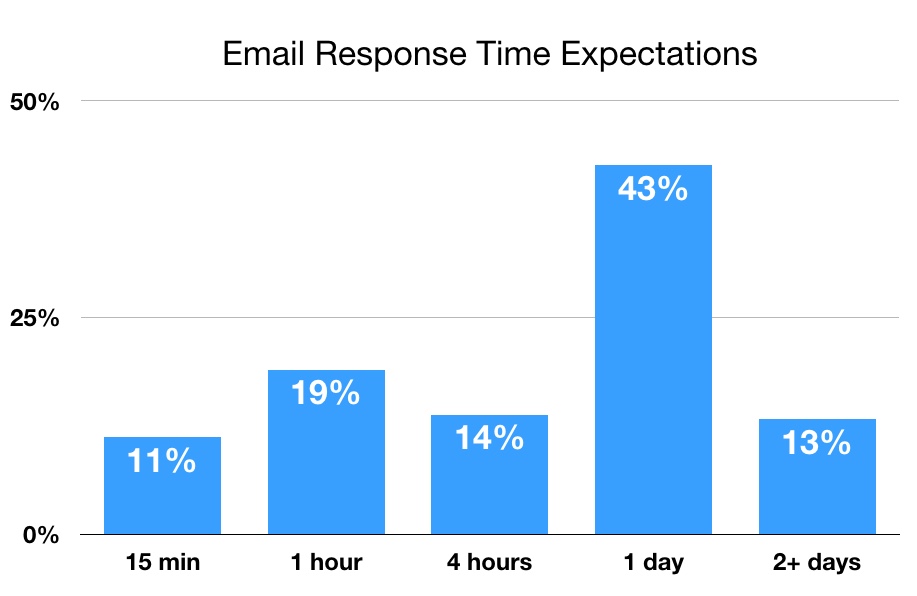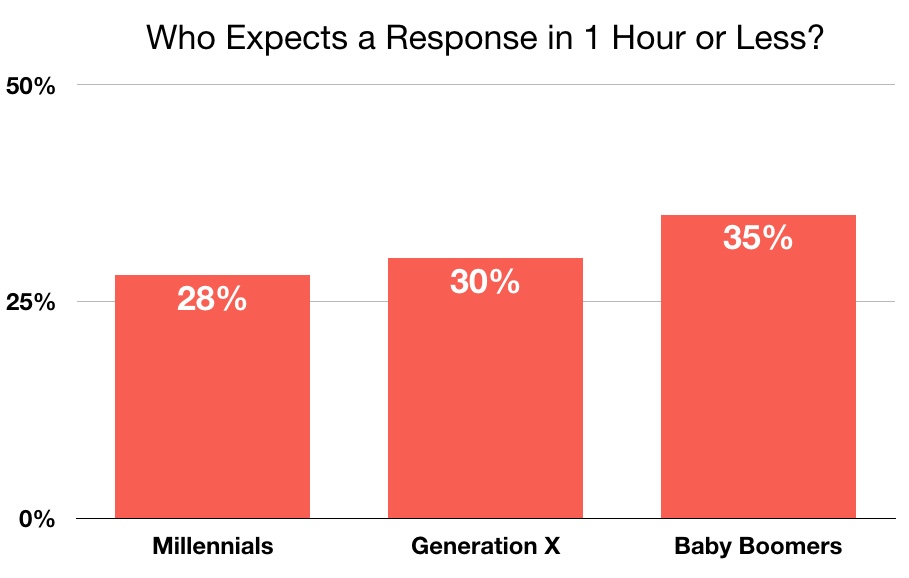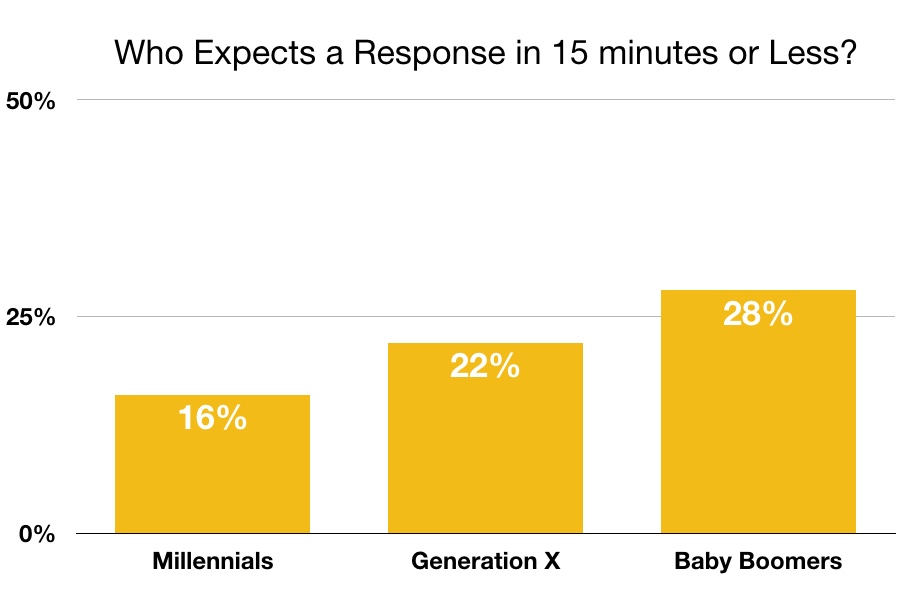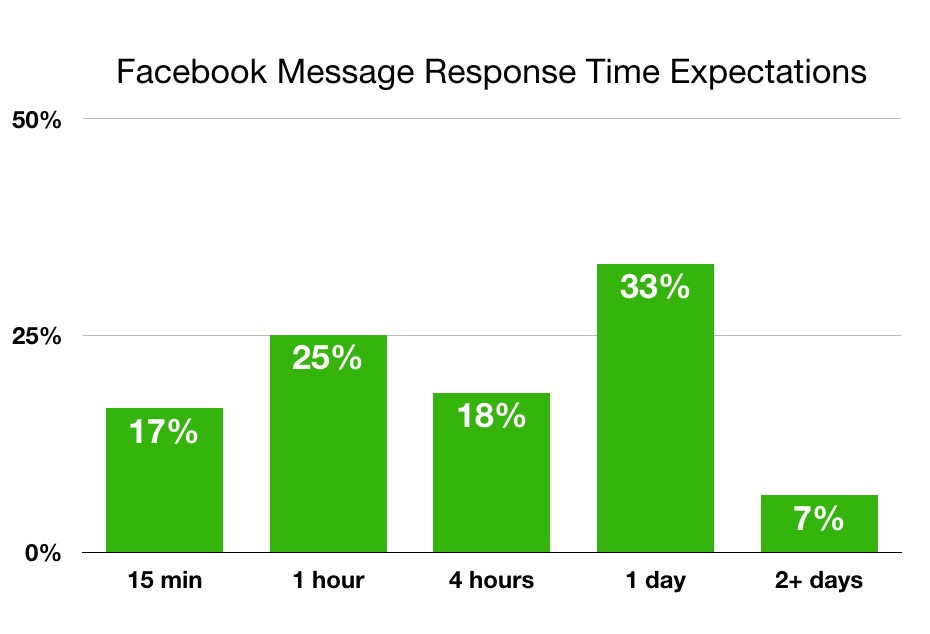One day is too long to respond to email.
A 24 hour response time was acceptable way back in the good old days of dial-up internet. That seems quaint in today's age of "always on" communication.
A new survey reveals nearly a third of customers expect businesses to respond to emails in one hour or less.
Separate research from customer relationship management software provider, SuperOffice, reveals the typical company takes 12 hours to respond to emails, potentially disappointing large groups of customers.
In one test, a whopping 62 percent of companies failed to respond to emails at all.
Keep reading to see the results of this latest survey, and get resources for improving your response time.
Study Overview
In March 2020, I surveyed more than 3,200 people to learn how quickly they expect businesses to respond to an email.
The study looked at different expectations by age. One surprising result was older customers demand the quickest responses. (More on that in a moment.)
Consumers from three countries were the primary participants:
United States
United Kingdom
Canada
There were some noticeable differences between consumers from each country.
Finally, a smaller group of 275 people responded to a second question asking how quickly they expected coworkers to respond to an email.
The study was generously sponsored by SuperOffice.
How fast should you respond to customer emails?
The recommended standard is one hour.
Responding in an hour will meet the expectations of 88 percent of consumers surveyed. While some customers are still okay with a 24 hour response time, many want to hear from you much faster.
There is some good news.
A small group of customers expect a response to their email within 15 minutes. That group is shrinking. Studies conducted in 2015 and 2018 focused on customers in the United States, so here's a comparison for American consumers for those three years:
Response time expectations vary by location
This was the first year the study included customers outside the United States. Customers in the United Kingdom and Canada want even faster service than their American counterparts.
An amazing 38.3 percent of Canadian consumers expect a response in one hour or less.
There are also regional differences within the United States. Here's how quickly consumers in each region expect companies to respond:
All of these results still suggest companies respond within one hour. However, companies might work on responding even faster if they primarily serve customers in Canada, the United Kingdom, or the Northeast region of the United States.
Response time expectations by age
Expectations even differ by age group. It might surprise you to learn that people aged 55-64 are the most demanding for fast responses:
Why do response times matter?
Slow responses can cost your company money, and eventually cost you customers.
Taking longer to respond runs the risk of alienating those customers and possibly prompting them to contact your company a second time, which increases contact volume.
A separate study discovered that waiting for a response was the number one reason customers complained on Twitter.
How fast should you respond to coworker emails?
The data here is a little scary, with 41.3 percent of respondents expecting a response in one hour or less.
The sample size for this group of 275 was too small to get useful results by region or age. However, the trends generally indicate that older workers expect faster responses.
There are two giant caveats to this data.
This question focuses on emailing an individual coworker, versus emailing a business that's presumably staffed by a team of people who can respond.
Expecting individual coworkers to respond in one hour is inherently unreasonable and unproductive.
Here's why:
Constantly checking email is distracting.
Responding too quickly creates half-baked responses that generate more email.
Many meetings last an hour. Do you really expect people to check email during meetings?
Additional Resources
One of the reasons I partnered with SuperOffice on this survey is they have spent a lot of time focusing on email responsiveness. For example, the company’s customer success team was able to reduce its average reply time from 5 hours down to 1 hour using a few simple steps.
Would you like to know how they did it?
Check out this webinar with me and Eirik Simonsen from SuperOffice to learn their secrets. We’ll show you how you can respond faster, too. You'll discover:
One thing that matters even more than speed.
How to improve your email workflow.
Counterintuitive ways your employees can respond faster.




















